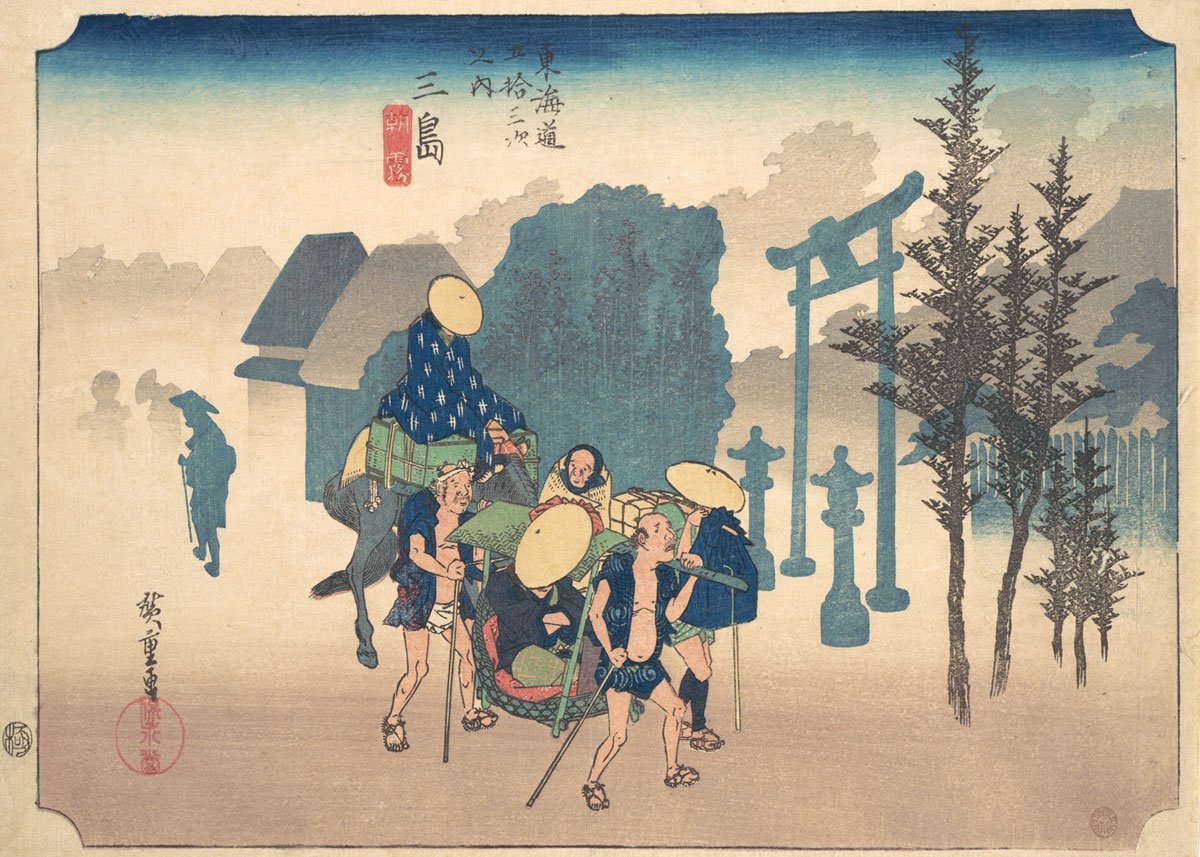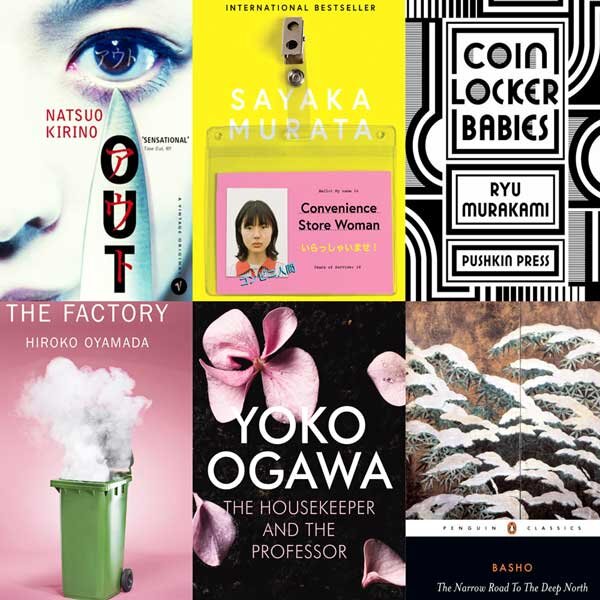20 Must-See Masterpieces of Japanese Landscape Painting
by Anne Walther and Jes Kalled | ART
Kawashima Shigenobu, Pictures of excursions through the famous sites of the capital, 1725-1750. National Museum of Asian Art, Washington D. C.
The earliest Japanese paintings were predominantly inspired by Chinese paintings and mostly embraced landscapes as their subjects.
Landscape is referred to as sansui in Japan, san meaning “mountain” and sui “water”. Consequently, many Japanese landscape paintings portray mountains and flowing water. From the fifteenth century, Japanese artists increasingly switched to landscapes of their own country, though they still adhered to the Chinese style and techniques.
In this 20 masterworks of Japanese art, we will take a tour through the most important media and themes beloved of Japanese landscape artists through the centuries.
1. Ukiyo-e (Woodblock Prints)
South Wind, Clear Sky (Red Fuji) by Katsushika Hokusai, 1830
From the famous Thirty-six Views of Mt Fuji series, in which the famous peak was depicted from thirty-six different perspectives, this landscape piece South Wind, Clear Sky is by none other than Katsushika Hokusai. The artist is considered an expert of ukiyo-e, particularly in the area of landscape. His woodblock prints resonated with the nation during the Edo period, when many people were concerned with domestic travel. This print, in particular, is a representation of the then iconic location to people of that time, one that remains an iconic symbol of Japan to this day.To find out more, check out Iconic Hokusai Prints: Thirty-Six Views of Mount Fuji.
2. The Tokaido Road
Fifty-three Stations of the Tokaido: The Lake at Hakone by Utagawa Hiroshige, 1833
The series titled, Fifty-three Stations of the Tokaido, gained much attention and gave ukiyo-e artist, Utagawa Hiroshige, a boost of popularity in the late Edo period. Here, in The Lake at Hakone, Hiroshige’s composition captures the beauty of the scenery, demonstrating not only his ability, but also his focus on the trend of landscape painting. Perhaps what is most compelling about this painting are the vibrant colors that capture the eye of the viewer, as if we too are walking along the Tokaido Road and pausing to take the landscape in.
3. The Tokaido Road II
Fifty-three Stations of the Tokaido Road: Morning Mist at Mishima by Utagawa Hiroshige, 1833
Somewhat coincidentally after Utagawa Hiroshige’s death, there was a sharp decline in the popularity of ukiyo-e. This was in part due to the influence of the west, which would later sweep through the art scene, reinforced especially by the Meiji Restoration. In Morning Mist at Mishima, however, we can see traditional Japanese aesthetics represented in the genre of ukiyo-e and landscape. This is represented in the travelers meandering through the mist along their journey on the domestic Tokaido road (which famously connected Edo to Kyoto) and in the misty background consisting of a torii gate, and shadowy and silhouetted trees. For more of Hiroshige’s work, head to Masterpieces by Hiroshige: 53 Stations of the Tokaido!
4. Sumi-e (Ink Painting)
Mountain Landscape by Tensho Shubun, early 15th Century
Kyoto painter, Tensho Shubun, is thought to be the first Japanese artist to pay close attention to the art of landscape in ink monochrome. This artwork dates back to the mid-15th century, when Japan’s elite were largely interested in the works of Chinese paintings. This landscape is notable for its thick, textured brush strokes, and the two trees located in the foreground–a tell-tale sign of Chinese influence.
If you’ve ever wanted to try Sumi-e yourself, check out All You Need to Know About Japanese Ink Painting.
5. Emakimono (Horizontal Rolls)
Unknown Japanese painter, Urashima Taro handscroll, 1590-1620. The Bodleian Library, Oxford
One of the oldest forms of Japanese paintings, emakimono were formed by assembling single sheets of paper together to form a single horizontal roll.
This highly interesting handscroll depicts a Japanese fairy tale named Urashima Taro. A fisherman, rewarded for rescuing a turtle, is carried on its back to a palace beneath the sea. As the guest of Princess Otohime, he loses track of time. This section illustrates the season of autumn in the kingdom under the sea. Upon his return, Urashima discovers that many years have passed in his village. Opening a magic box offered to him by Otohime, he starts to age.
6. Kakemono (Vertical Scrolls)
Kano Tan'yu, Spring Landscape, 1672. Freer Gallery of Art, Washington, D.C.
During the Edo period (1603-1868), vertical scrolls, named kakemono, became highly popular. They are still used nowadays in small Japanese houses to adorn the walls and can be displayed or concealed easily depending on the season and circumstance. They often decorate tea houses and add a distinctive flair to tea ceremonies held on special occasions.
This almost monochrome kakemono in Chinese style was typical of the early works of the Kano school of painting. The Kano school is one of the most famous schools of Japanese painting, being the dominant style of painting from the late fifteenth century until the Meiji period (1868-1912). While still producing monochrome brush paintings in Chinese styles, the Kano school developed a distinctive colored and strongly outlined style for large panels decorating the castles of the nobility.
Often the appeal of Japanese art is in its simplicity. Check out these 15 Finest Japanese Drawings for more!
7. Byobu (Folding Screens)
Unknown Japanese painter, Scenes in and around Kyoto, left-hand screen, 1613-1624. Kobe City Museum
Byobu folding screens became a major medium for luxuriant and intricate Japanese paintings. They were mostly used in temples and palaces due to their large sizes.
This pair of screen paintings depicts the city and surrounding landscape of Kyoto in the early seventeenth century. On the left-hand screen are displayed various temples and shrines from the northern part of Kyoto. In the foreground, the main tower of the Nijo castle can be recognized. In the background, we distinguish Kinkakuji (Golden Pavilion) and the Togetsu-kyo bridge in the Arashiyama area.
Unknown Japanese painter, Scenes in and around Kyoto, right-hand screen, 1613-1624. Kobe City Museum
In the middle of the right-hand screen, we distinguish the Takasegawa canal. Across the Kamo river, the two bridges of Sanjo ohashi and Gojo ohashi are recognizable. Temples and shrines in the Rakuto (Higashiyama) area are also pictured.
8. Pine Trees
Pine Trees by Hasegawa Touhaku, c. 1595
Pine Trees by Hasegawa Touhaku is considered one of his most impressive masterpieces. Painted with ink onto washi paper, the pair of folding screens fall into the category of Byobu, detailed artworks that adorn a room by dividing it with their fragile but beautiful walls. This landscape has a blurred aesthetic, perhaps owed to the possibility Touhaku could have been painting his hometown in Noto from memory. Learn more about Hasegawa Tohaku: The Timeless Giant of Japanese Art.
9. Fusuma (Sliding Doors)
Tosa Mitsumochi, Horse-breaking, 1560-1569. British Museum
Sliding doors, named fusuma, have long been another important medium for Japanese landscape painting, especially in temples.
Here is a panoramic autumn mountain scene with maple trees changing color. The artist Tosa Mitsumochi used ink and delicate light colors on the figures, horses and rocks. The subject, men training horses, is a part of a general landscape scene in which the artist attempted to unite Chinese and Japanese painting techniques. These fusuma as a pair were perhaps part of a larger set.
10. Sensu / Ogi (Fans)
Kano Soshu, Early Christian Church in Kyoto, late sixteenth century. Kobe City Museum
In the Western tradition of landscape painting, the most common media were canvas, paper, or wooden panels. The Japanese tradition went further into the field of applied arts, using landscape paintings to adorn rolls, scrolls, folding screens, sliding doors, and even fans.
According to this fan painting, the early Namban-dera Christian church was located in a wooden three-story building in the western part of Kyoto. This church was demolished in 1587 and this fan is the only visual testimony of its existence.
If you would like to know more about these unique art pieces head over to 5 Things You Should Know About Traditional Japanese Fans.
11. Shiki-e (Landscapes during the Four Seasons)
Kano Eino, Birds and Flowers of Summer, late seventeenth century. Suntory Museum of Art, Tokyo
The combination of lavishly colored seasonal birds and flowers was part of the Kano school’s range of flora and fauna linked to the four seasons. The landscape composition of these panels on gold ground and with golden clouds is typical from the Kano school’s repertoire.
This screen depicts summer with pine trees, wisteria, black paradise flycatchers and reddish turtle doves. From the Heian period (794-1185), Japanese painters depicted trees, mountains and lakes as backgrounds to Buddhist themes, or the seasons of the year (shiki-e). This masterpieces was created by Kano Eino (1631-1697), painter and the editor of the Honcho Gashi, the renowned history of Japanese painting.
12. Winter Landscape
Winter Landscape by Sesshu Toyo, early 16th Century
One of the most well known artists in Japanese art history is Sesshu Toyo; he is recognized for his unique style of painting and his widespread influence as a teacher and Buddhist priest. The artist was strongly impacted by Chinese art, and sought to bridge the two cultures together in his work whilst also infusing his buddhist aesthetics and beliefs. Widely regarded as one of his most famous paintings, Winter Landscape embodies the idea of mono no aware, “the pathos of things,” or human-ness in nature. Winter Landscape depicts a man walking up a three dimensional yet flat landscape, invoking feelings of seclusion.
13. Snowy Landscape
Snowy Landscape by Kano Hogai, 1883
This ink on paper piece is attributed to artist Kano Hogai. Hogai was from a family of painters, and studied how to paint formally under the Kano school. Japan’s increasing interest in the west caused many Japanese-styled paintings and traditions to fall by the wayside. Hogai joined the Painting Appreciation Society, Kangakai, in an effort to preserve the traditions of Japanese paintings and arts, and continue the teachings he had learned to honor. Snowy Landscape depicts a quiet picturesque cabin in the mountains. Hogai uses black ink on colored paper in the nihonga style to reinforce his movement to keep Japanese traditional paintings alive.
14. Meisho-e (Views of Famous Places)
Kano Isen’in Naganobu, Twelve Famous Places in Japan, an album of 12 paintings, 1800-1850. British Museum
This view is extracted from an album named sansui gajo (landscape paintings) that are, rather, meisho-e (views of famous places). This traditional theme in Japanese landscape painting dates back to the Heian period (794-1185). Here is Mount Yoshino near Nara, covered with cherry blossoms. The muted colors and delicate brushwork are remarkable. Kano Isen’in Naganobu was an artist of significant talent and an official painter to the shogun.
15. Riverscape
The Hozu River by Maruyama Okyo, 1789
Another student of the Kano school, Maruyama Okyo became well known for his distinctive style and adaptations to Japanese traditional painting. The artist combined his knowledge of realist Chinese painting techniques with his own flair of what could be called impressionistic. The Hozu River is a great example of the charm and beautiful atmosphere he wanted to invoke in his paintings; the clouds giving off a dreamy—maybe heavenly feeling. Okyo seemed to want to convey through painting the “reality” of beauty in a landscape; its effect as a feeling we experience rather than something we are literally seeing.
16. Monogatari-e (Life Scenes at the Imperial Court in Kyoto)
Kano Ryusetsu Hidenobu, Genji monogatari (The Tale of Genji), a pair of handscroll paintings, 1650-1750. British Museum
The Tale of Genji is a famous eleventh-century novel relating the love and life of Prince Genji, a fictive character, at the court. Various schools realized Genji-e (Genji pictures) in diverse styles and techniques. The scene depicted here shows a painting competition between two princesses to win the emperor’s favor. In the convention of Genji-e, the rooms are viewed as if their roofs were removed and surrounded with landscape details. The sprinkling of gold dust around the scene and its landscape elements evokes the luxurious atmosphere of the imperial court in the Heian period (1784-1185). For more see Tale of Genji: Masterpieces of Japanese Art.
17. Landscape in the Mist
Landscape in the Mist by Utagawa Kunisada, mid 19th Century
In the mid-19th century, many artists were keen to paint famous and iconic places. Here in Landscape in the Mist, artist Utagawa Kunisada has broken free of this habit of the times, and instead depicted a landscape piece in which Mt.Fuji–though present–is not the protagonist. The color and misty atmosphere seem to want to tell us of a feeling rather than a place. Discover more of Utagawa Kunisada: 10 Must-See Masterpieces.
18. Rural Landscape
Seba by Utagawa Hiroshige, 1835
Utagawa Hiroshige’s Twilight view of Seba is one from a series titled, Sixty-nine Stations on the Kisokaido. A moon shines through the trees; two men push through the water on boats loaded with wood—and all seems quiet and calm in this rural landscape. The most famous in the series is this landscape piece of blues and greens and weeds on the Narai river.
19. Nanban Byobu (Scenes of Portuguese and Dutch Ships in Japan)
Unknown Japanese painter, Arrival of a Portuguese ship, one of a pair of nanban screens, 1620-1640. Asian Art Museum, San Francisco
Early Japanese artists were fascinated by the Westerners, and especially the Portuguese, because of their exotic appearance, costumes, language, merchandise, and ships. From the sixteenth century until 1641, when Christianity was banned by the Japanese government, Portuguese trade with Japan was prosperous. Japanese merchants exchanged lacquer ware, silk, silver, and swords with the Portuguese who brought cotton, gold, lead, silk, lead and wool to Japan.
The foreign explorers were depicted in great details in Japanese paintings and were named nanban (southern barbarians) because they sailed to Japan from the south. This work depicts the arrival of a Portuguese ship at the port of Nagasaki. Even if the viewer’s eye is focused on the scene, the surrounding landscape still plays a prominent part.
20. Rakuchu Rakugai-zu (Views in and around the Capital of Kyoto)
Kawashima Shigenobu, Pictures of excursions through the famous sites of the capital, 1725-1750. National Museum of Asian Art, Washington D. C.
A legendary view of Kyoto is, of course, Kiyomizu-dera, an ancient Buddhist temple founded in 798 and located on the hills east of the former capital. Nowadays, Kiyomizu-dera has remained a famous site for excursions and pilgrimages. This illustration is part of a long handscroll of renowned views around Kyoto. Visitors today may appreciate the same views as experienced by this eighteenth-century artist.














ART | October 6, 2023